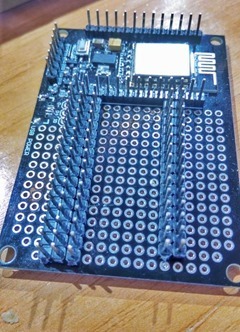 If you’re going to experiment with I2C – may as well do it the easy way. Having spent the past few days with a desk that looks remarkably like a bowl of spaghetti, I’ve finally gotten around to making a special IOTBEAR board up for the job. 18 each of ground, +3v3 and +5v lines – and 16 each of GPIO4 and GPIO5.
If you’re going to experiment with I2C – may as well do it the easy way. Having spent the past few days with a desk that looks remarkably like a bowl of spaghetti, I’ve finally gotten around to making a special IOTBEAR board up for the job. 18 each of ground, +3v3 and +5v lines – and 16 each of GPIO4 and GPIO5.
This gave me the opportunity to tackle that long string problem in Arduino Wire. A brief attempt with the logic analyser suggested that my ESP i2c was sending out at least one byte more than the Arduino was receiving – impossible to tell if more because the ESP would stop sending as soon as the Arduino would stop receiving.
And that brings me to a question – is anyone aware of a nice, pretty I2c and other protocol analyser based on a Raspberry Pi? Seems to me that would be a good use for an old RPI2?
Anyway I digress… I’ve had issues with I2c experiments in the past – usually when sending strings. I’ve looked up the issue on Google and found nothing. I was convinced it was a timing issue and at that point I Skyped my friend Peter Oakes in Canada – just as with Aidan who you’ll have read about in here, I often find that “two heads are better than one” when I’m getting bogged down.
We started sending I2c strings to the Arduino who’s receive buffer I’d put a Serial.println() statement in – to see how many characters it THOUGHT it was receiving.
29…. 30… 31… 32… 32 – EH
As I increased the length of string sent from the ESP (using ESP software I2c) to the Arduino (using the WIRE library) at 33 characters the Arduino thought it was getting 32 – at 34 it went to meet it’s maker.
VOILA – the WIRE library clearly has a buffer to store stuff – I did not believe at first that 1. the buffer would be so small and 2. this would result in a crude crash. I went into the Wire Library (that’s a long story – I have dozens of WIRE libraries and it took a while to find the right one) – updated the buffer size in wire.h and… nothing – made no difference. I introduced an error into the .h file to make sure I had the right one – sure enough – but no joy on fixing the problem.
I don’t know if Peter or I twigged first but in my ESP SERIAL buffering which I wrote myself, I have a 256 buffer for incoming characters – which fills until it gets a CRLF then transfers that to an output buffer of the same size – so that incoming characters can continue to arrive while processing the buffer. It occurred to us that maybe the Wire library has the same setup – SURE ENOUGH. Not only is there a buffer definition in arduino/hardware/arduino/avr/libraries/wire/src/wire.h but also in arduino/hardware/arduino/avr/libraries/wire/src/utility/twi.h
And yes, the directory structure IS that complicated (I’m on Arduino 1.69) – sure enough two separate 32 byte buffers are created. As I have never seen this covered so I assume I’m the only person in the world who’s ever sent 32 bytes via I2c… but if you’re about to try the same – and you’ll need to if you want to try my peripheral software, then I suggest despite the deep hole this will leave in RAM (all 2K of it) – making both of these 128 bytes.
Since amending and re-compiling – I can now send long strings to the Arduino absolutely to my heart’s content!
{nano:9,7,”how are you today and the weather is nice – NO REALLY it certainly is.”,0}
Around 15ms in total – not stunningly fast but fast enough not to interfere with the running of anything.
For more on I2C – see the blog entry “Faster ESP I2C”

Interesting board with Grove connectors: http://m.banggood.com/ESP8266-WiFi-Grove-Board-Kit-PMS5003-WiFi-Sensor-Remote-Control-Shield-Module-p-1060273.html?
Protocol analyzer with RPi… These can help?
http://tuxbabe.eu/raspalyzer.html
https://github.com/richardghirst/Panalyzer/blob/master/README
I didn’t think of Bitscope – I have one of those too.
Actually the Saleae logic analyser is more advanced than those – and that’s what I’m using – and in the meantime it has all become a lot clearer. Amazing what happens when you use the right tools – thanks for the links.
You’re welcome
Also bear in mind that by default the BUFFER_LENGTH parameter is used to create both receive and transmit buffers giving a total of 4 times the length defined being used.
Correct – well, it’ll have to do – uses lots of RAM but then I don’t have a fantastic use for the rest of the RAM. I still have around 500 bytes left after all of this AND running a QTECH display (not documented as I’m still working on it) so there’s lots of room for more goodies in there. As it happens I’ve mentioned another more powerful board, which if the Arduino IDE support for it works as claimed will be much better suited to this – still awaiting delivery from China – for now – as of a little while ago – all working – just updating now.
can we see the back too? thanks
very kind seller, i bought 2 small and 2 big of his boards 🙂